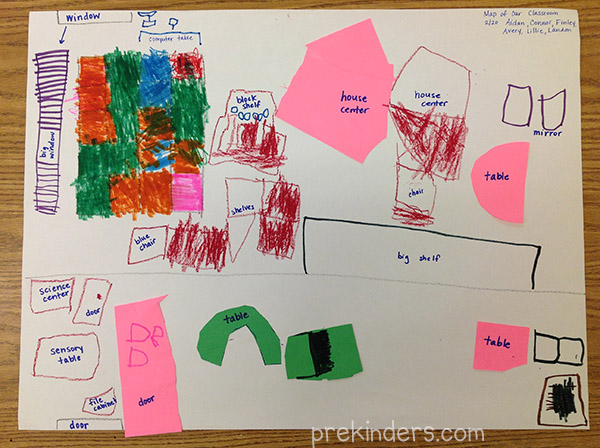My class this year has been fascinated with maps. They love to look at the maps we have in the block center, and they often draw maps in the art center. Treasure maps, maps of their town, maps to show their bus route, maps from their house to their friends’ house.

Making a Map of Our Classroom
One day for a small group activity, we made maps of our classroom as a cooperative group activity. We used 18×24 inch paper.
I drew the window, door, and large group carpet on the map to get them started. I pointed out the door in our room and the door on our map, and did the same with the window and carpet.
We talked about things we needed to put on the map. Each group came up with some different ideas, for example, only one group thought about putting the clock on the map.
I also thought it was neat that one group put the “Pigeon book” on the map (Don’t Let the Pigeon Drive the Bus, by Mo Willems — a Pre-K favorite).
Most of the things they put on the map were drawn on construction paper, cut out, and glued to the map. That helped because if someone put something in the wrong place, we could talk about it as a group, and move it where it needed to be. Here are our results:




As a follow up activity, I read the book Me on the Map, by Joan Sweeney.
Penny Maps: 3-D Maps with Children
Pre-K teacher, Nancy Earnest, shared with me her method of teaching map skills. I asked Nancy if she would mind sharing it on PreKinders. Nancy recommends making model maps of the classroom in 3D before making a paper map by using Legos, blocks, Unifix cubes, or other 3D materials.
The following was written by Nancy Earnest:
To make a 3D map, I took birds eye view photos of the shelves and put them on wood pieces. The birds eye view photos can be made by standing on a chair or step ladder. The base for the tables are plastic jar lids and the table tops are cut up corrugated boxes. The other pieces are cut from scrap wood. Using the mini furniture models, children were able to make a classroom model.
I then hide a penny in the classroom and indicate its location on the model map with a paper X.

My students also enjoy making a model of the outdoor play area with clay and sticks.
Inspiration for this activity come from the book Mapmaking with Children, by David Sobel. His book includes research about children’s maps and curriculum related to developing a child’s sense of place.
On Chebeague Island, Maine, the children in Miss Nancy’s PreK class play Penny Maps inspired by David Sobel’s book, Mapmaking with Children.
